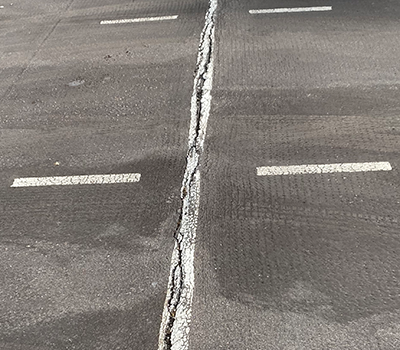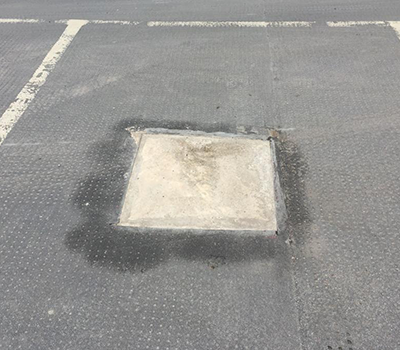Asphalt covered car park decks are commonly found in multi-storey car parks, on decks and ramps exposed to the elements or internal decks over occupied premises. The outward appearance of the asphalt surface and visual presentation of faults are indicators of potential issues. Listed here are the main symptoms of problems that pose the biggest risks to the waterproofing, structural integrity or safety of car park users.
You can also download our Triflex 'Solutions for failing asphalt: multi-storey car parks' here.
1. Asphalt cracking
Cracks in the waterproofing allow a direct path for water and chloride ingress as well as carbonation. They most commonly occur in the weaker asphalt day joints or at upstands and interface details. Large car park structures will have numerous asphalt day joints and details creating a significant number of high risk zones.
Cracks are also found in the asphalt surface, where aged asphalt has shrunk. As the flux oils and other volatiles are lost from asphalt, it becomes less flexible and shrinks due to loss of mass.
Alternatively, if the separating tissue between the asphalt and underlying concrete is damaged or missing, the asphalt may stick to the concrete. As the asphalt is designed to allow movement during temperature changes, it may tear and crack if adhered to the substrate. Similarly, cracking and movement in the underlying concrete transfers directly into the asphalt, resulting in crack formation in the asphalt.
Cracks are aggravated by standing water and freeze-thaw cycling during cold weather. Ice expansion will force cracks to open wider, with general trafficking causing further damage, i.e. a small crack in the summer can be significantly larger in the winter. Cracks can also present a trip hazard to users, encourage vegetation growth and continue to grow in width, but fundamentally can compromise the waterproofing and protection of the structure.
2. Asphalt details and interfaces
Roofing grade mastic asphalt is used to form interfaces with other details. All of
these details whether upstands, drainage outlets, channels, posts, or plinths etc. are potential failure points for asphalt waterproofing.
These areas are vulnerable because the asphalt to the main area is de-bonded and can move freely, whereas the asphalt details are bonded. Structural movement, as well as thermal expansion and contraction will place significant stress on the asphalt at these interfaces, particularly during cold weather when the thermoplastic asphalt is most brittle.
These issues can manifest in the form of tears and cracks at the interfaces allowing a direct path for water, chlorides and carbonation.
3. Blisters in asphalt
Blisters are caused by trapped moisture and air heating up to create a vapour
pressure. This moisture may be in the substrate beneath the asphalt or between the
asphalt layers (interstitial) in multi-layer systems found in car parks. The blistering can occur soon after installation, or in some cases, take many years to form. The blisters can also continue to expand progressively due to a cyclical pumping action.
Evident as raised or domed areas, blisters vary from a few centimetres across to a few metres or more. They can occur singularly but are commonly found in clusters, particularly on ramps where the asphalt is fully bonded. Besides being a trip hazard, blisters need repair. Left alone they may collapse and compromise the waterproofing integrity, risking structural damage.
4. Surface ponding
It is recommended that falls in car park decks should be a minimum of 1:60.
Unfortunately, the designed and as-built construction do not always match, and
ponding is common on asphalt surfaced car parks. Causes include poor construction, deflection within the structure, insufficiently designed falls and a lack of or poorly located drainage outlets.
Mainly considered as an inconvenience, ponding water is avoided by pedestrians who want to keep their feet dry. However, frozen ponded water presents a severe health and safety slip hazard for pedestrians and in extreme circumstances, vehicles. The reason this often gets left untreated is that asphalt cannot be laid to falls to correct inherent issues, and cannot be laid on top of existing asphalt once the issue has appeared.
5. Tyre indentations
Where asphalt lacks enough stone content at the surface or is soft, tyre impressions or wheel indentations commonly form. As heavier electric vehicles increase in number, and temperatures rise due to climate change, the frequency of these will increase. Asphalt surfaces are softer where the ratio of bitumen-rich material to aggregate is higher. This can be due to variations in the size or amount of aggregate in the paving grade wearing layer or a paving asphalt layer which is applied too hot.
A bitumen-rich surface becomes even softer in high temperatures or when heat load dissipates from a vehicle, due to the bitumen’s thermoplastic properties. Indentations are often worsened by the displacement of asphalt to the perimeter. The resulting lip can lead to localised ponding, a trip hazard or icy patches in winter, directly where vehicles are designed to stop.
6. Skid risk from worn asphalt
As asphalt ages and is trafficked extensively, the paving asphalt can wear and polish to a hazardous state. Crimped finishes and wearing layers are worn to a flat, smooth, shiny surface that is slippery when wet.
Ramps, ramp aprons and turning areas are especially susceptible due to the heavy shear forces from vehicle tyres. With virtually no anti-skid, traction is compromised causing a significant skid risk to vehicles and a slip risk for pedestrians.
With significant liabilities for owners and operators arising from any form of slip or accident, the maintenance of adequate slip resistance measured as pendulum test values (PTV) is a must.
7. Slumping
High thermal loads cause thermoplastic asphalt to soften, particularly the roofing grade mastic asphalt exposed at details. South facing aspects, or surfaces where heat or sunlight is reflected from buildings are especially vulnerable. Softened asphalt becomes mobile and will slump, especially on vertical details such as upstands and stair risers.
This slumping can occur to such an extent that the asphalt falls off the detail or tears under its own weight. Both can compromise the waterproofing integrity and create a dangerous trip hazard on stairs.
As with any issue which can compromise waterproofing, the failure will facilitate chloride and carbonation ingress.
8. Asphalt contamination
Solvents such as fuel spills, oil deposits and other contaminants can attack bitumen-based asphalt. This causes it to lose its physical and mechanical properties leading to degradation and even break up.
The asphalt’s reduced strength is prone to accelerated wear and left untreated, will prematurely fail.
9. Asphalt repairs
Asphalt patch repairs are commonly seen in asphalt substrates and although there are complex methodologies for such repairs, these seem rarely followed. Shrinkage related failures regularly occur with cracks opening at the perimeter of the repair, allowing water ingress.
Incompatible materials such as tarmac, cold asphalt type solutions or even concrete are frequently used. These not only fail to provide a long-term solution but are not waterproof. Use of these materials allows water and chloride ingress which can cause structural issues and accelerate the failure of the original asphalt.
At Triflex, we see a lot of asphalt! As one of the UK’s leading suppliers and specifiers of waterproofing and protection systems we’ve seen every type of asphalt issue. Whilst a common and hard-wearing material, once issues start to appear, it’s time to call the specialists in.
We are experts in the overlaying of asphalt and our systems have been applied to 2 million m² of asphalt in the UK alone. We undertake thorough surveys including core testing to see what lies beneath to specify the right waterproofing and protection system for your car park, walkway, balcony, terrace or roof.
For more information, expert advice, survey, and sustainable solutions contact us today.











